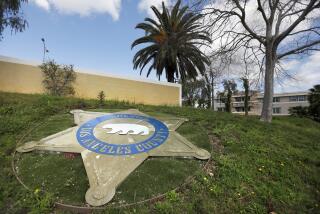State agencies feud over off-roading along seaside dunes

New battle over public use of the beach and sand dunes along the coast near Pismo Beach.
The decades-long battle over public use of the beach and sand dunes along the coast near Pismo Beach fractured into a new front this month, with one state agency accusing another of taking more than 30 years to accomplish a regulatory task that was supposed to take less than two.
California Coastal Commission staffers, in a Jan. 11 report, accused the California Department of Parks and Recreation’s Off-Highway Motor Vehicle Division of being more than three decades behind schedule in meeting key requirements of a coastal development permit issued for the Oceano Dunes State Vehicular Recreation Area — the state beach where motor vehicles can crash through the surf.
Under the 1982 permit, state parks had 18 months to determine the number of vehicles the park can handle daily, and establish a permanent entrance to minimize damage to habitat for federally endangered steelhead trout and two species of birds: the Western snowy plover and the California least tern.
But the agency never completed the process. The 1,500 acres of the park accessible to vehicles have been operating under an “interim” system with a limit of 4,300 vehicles a day and a main entrance that forces visitors to drive through trout habitat at the mouth of Arroyo Grande Creek to get to a staging area for unloading dune buggies and motorbikes. The commission report calls this “a three-decade-old unresolved issue and a potential violation.”
In addition to the threat to the area’s plants and animals, environmentalists accuse the off-road enthusiasts of kicking up noxious dust that blows onto downwind communities.
This dispute is dispiriting and frustrating
— Arlene Versaw, former San Luis Obispo County commissioner
The off-road area attracts nearly 2 million people a year and injects about $171 million into the San Luis Obispo County economy.
A passionate contingent of enthusiasts relish flying over the coastal dunes in customized “sand rails,” roaring over the wet sand on dirt bikes and kicking up roostertails on high-powered ATVs. Many have been coming to the dunes for generations, and they say the activity strengthens family bonds.
State parks officials say they had not anticipated the Coastal Commission’s report.
“We’re surprised by these allegations,” said Matthew Fuzie, acting deputy director of state parks’ Off-Highway Motor Vehicle Division. “Not once in more than 30 years has the commission challenged our existing operation, or taken action to finalize it.”
The state agencies hope to resolve their differences at a meeting in September. That won’t be easy.
“Both agencies are in a tough position,” said Noaki Schwartz, a spokesperson for the commission. “The Coastal Act protects habitat and wildlife, and State Parks has to implement a legislative mandate for driving on the dunes. We can’t predict what the outcome will be.”
Partisans on both sides of the bitter fight said they find the inter-agency tension unfortunate.
“This dispute is dispiriting and frustrating,” said Arlene Versaw, 72, a former county commissioner who resides in nearby Nipomo Mesa, where particulate pollution routinely exceeds state standards. “These agencies are supposed to be taking care of the environment and our health.” she added, shaking her head wearily.
Craig Angello, 34, a spokesman for Friends of Oceano Dunes, a group off-road vehicle enthusiasts, and owner of an off-road vehicle rental business near the main entrance to the park, agreed: “It’s beyond sad that those guys aren’t getting along.”
The dispute comes after a third state agency, the California Air Resources Board, plunged headlong into the fray by developing a three-dimensional atmospheric and terrain computer model of the seaside dunes and nearby housing tracts.
The model is expected to be used later this year to determine the location of potential airborne particulate concentrations under various emissions and meteorological scenarios, and then develop methods of reducing them.
Leaders of the off-road contingent have long challenged air-quality experts’ evidence that intensive vehicle use is largely responsible for an pollution problem in nearby downwind communities that are home to more than 20,000 people.
They also chafe at the fact that the area they’re now allowed to enjoy is only about 10% of the 15,000 acres they roamed a few decades back.
Moments after park staff opened the entrance gate on Thursday, off-roaders rumbled along the surf’s edge like a nomadic caravan, their trucks and Jeeps loaded with rugged dirt bikes and sand rails. Flying American and Mexican flags, they splashed through the knee-deep creek en route to a staging area before rocketing off in all directions.
The forces that hope to stop them also keep gathering.
A group of homeowners from Nipomo Mesa has filed a lawsuit in San Luis Obispo County Superior Court against state parks, the county and its Board of Supervisors seeking a permanent injunction barring off-road activities in the park until the air pollution problem is mitigated.
“I believe we will ultimately prevail against this threat to human health in the courts,” said Versaw, the former commissioner and a plaintiff in this lawsuit. “If we leave it up to our elected officials and regulatory agencies, it’ll drag on for another 35 years.”
ALSO
What all those dead trees mean for the Sierra Nevada
Santa Monica Airport will close in 2028 and be replaced by a park, officials say
UC urges students, faculty covered by Trump travel restrictions to stay in U.S. for now
More to Read
Start your day right
Sign up for Essential California for news, features and recommendations from the L.A. Times and beyond in your inbox six days a week.
You may occasionally receive promotional content from the Los Angeles Times.







